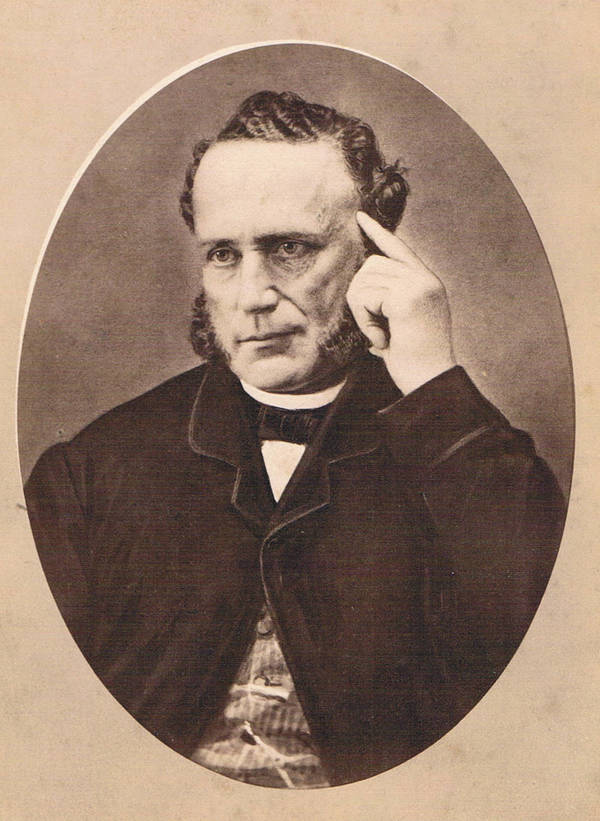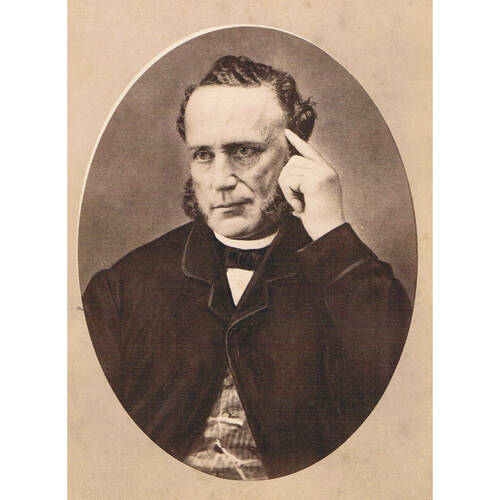
Source: Link
TROOP, JACOB VALENTINE, businessman, shipowner, and politician; b. 28 July 1809 in Granville Ferry, N.S., second son of Valentine Troop and Tamar Bath; m. 11 July 1838 Catherine Fellows, and they had two sons and three daughters; d. 3 Oct. 1881 at Saint John, N.B.
In the late 1830s Jacob Valentine Troop, a merchant in Upper Granville, N.S., moved with his wife and young son to Saint John where he opened a general store on North Market Wharf. Located in a prosperous shipping centre, Troop soon realized that greater profits could be made by acquiring a vessel to transport fish and lumber to the West Indies and to return with sugar and molasses for his store. In 1847 he purchased a half-interest in the 60-ton schooner Kate. Later in the same year he acquired the first of several small vessels constructed in Granville Township, mainly by Abraham Young, for trade with the West Indies. Although by 1851 Troop was concentrating on shipping, he had also invested in real estate and was probably involved in some shipbuilding. The agents of R. G. Dun and Company noted in 1854 that he was expanding his business “cautiously and successfully.”
From 1847 to 1879 Troop held shares in at least 61 vessels. He owned many of these in partnership with his eldest son Howard Douglas who in 1864 was taken into the firm (known thereafter as Troop and Son): the younger son, Jacob V. Jr., seems to have joined the company only after 1880. In 1864 Troop began a long and profitable association with shipbuilder John Stewart Parker of Tynemouth Creek, Saint John County, when he contracted to have the 669-ton Bessie Parker built. In the late 1860s, as trade with the West Indies became less profitable, the firm started acquiring larger vessels for the transoceanic trade and the Troop fleet was soon found in the four corners of the world. Among the vessels Parker built for the Troop fleet in the 1860s and 1870s were the 1,232-ton Jacob V. Troop, the 1,544-ton Howard D. Troop, and the 1,295-ton J. V. Troop. Another prominent New Brunswick shipbuilder, David Lynch, built numerous vessels for the Troops throughout the 1870s and 1880s, including barques, such as the 1,699-ton Cedar Croft, and the ship Rock Terrace, the largest of Troop’s Canadian-built vessels at 1,769 tons. Troop and Son also acted as commission merchants and ship-brokers. In 1872 R. G. Dun’s agents reported that profits for the previous year were “in the neighborhood of $100,000.” Troop, they further noted, “is a keen able manager & his son is a hard working shrewd man.” Although later reports indicated that the firm had lost several vessels with little or no insurance, they still recorded substantial profits for it throughout the 1870s.
Troop’s involvement in other areas was usually limited to pursuits associated with his business and financial concerns. From 1859 to 1871 he served on the managing and arbitration committees of the local chamber of commerce and he acted as port warden in 1862. Fearing that the legislative union of the British North American colonies would hurt the economy of New Brunswick, he decided to enter politics in 1865 to oppose confederation. On 4 March he and Andrew Rainsford Wetmore* were elected to represent the city of Saint John, defeating Samuel Leonard Tilley* and Charles Watters, and Wetmore served briefly in the cabinet of Albert James Smith. In the electoral contest of the following year, however, Wetmore joined forces with the pro-confederate Tilley. They defeated Troop and Samuel Robert Thomson*, New Brunswick entered confederation, and Troop never returned to politics. He became involved, to a limited extent, in the financial community of Saint John. A member of the board of directors of the Commercial Bank of New Brunswick in 1865, he was still a small shareholder in 1868, the year the bank failed. He was also one of the first directors of the Maritime Bank of the Dominion of Canada, formed at Saint John in 1872. Perhaps anticipating the problems the bank would encounter before its failure in 1887, Troop remained a director only until 1875.
In 1873 Troop became ill but continued to attend to his business affairs, including the inspection of every vessel before it left port. His death on 3 Oct. 1881 was precipitated by injuries sustained a few weeks earlier when he had fallen into the hold of one of his vessels. He left an estate valued at $110,000.
Estimates of the size of the entire fleet which the Troops had owned in whole or in part since 1847 vary from 84 to 96 vessels and may be incomplete. In addition, Troop and Son had also acted as agents for several shipping lines, including the Cunard Line, the White Star Line, and the Beaver Line. Howard Douglas continued to expand the Troop fleet after his father’s death, adding in later years iron and steel vessels built in England and Scotland. In addition he acquired two steamships, also built in Great Britain. The firm, however, began to sustain heavy losses and at the time of Howard Douglas’s death in 1912, the only vessel flying the Troop flag, the familiar red “T” in a white diamond on a blue background, was the magnificent four-masted 2,180-ton steel barque, Howard D. Troop. It was sold in that year and the era of the Troop fleet was over.
[The early business papers of Troop and Son, Saint John, N.B., were destroyed in the fire of 1877 and no records from the later period have been located. v.s.]
Baker Library, R. G. Dun & Co. credit ledger, Canada, 9: 70, 557k. Maritime Hist. Group Arch., Troop name file. N.B. Museum, G. H. Markham, “Digby biographical notes,” 163; Millidge family papers; Parker family, account books, 1823–86; Troop family file; W. W. White coll. PAC, RG 42, ser. 1, 143–46 (mfm. at N.B. Museum). PANB, RG 7, RS71, J. V. Troop, 1881. UNBL, [Raymond Foster], “History of the shipbuilding industry in New Brunswick” (typescript, 1933). Daily Sun (Saint John), 3 Oct. 1881. Saint John Globe, 3 Oct. 1881. Pedigree of Troop (Troup), Canada, comp. J. D. E. Troop ([Sutton West, Ont.], 1974). The Troop fleet in the days of sail: exhibition arranged by the Department of Canadian History, the New Brunswick Museum, 1960 ([Saint John, 1960]). Esther Clark Wright, Saint John ships and their builders (Wolfville, N. S., [1975]). S. T. Spicer, Masters of sail: the era of square-rigged vessels in the Maritime provinces (Toronto, 1968). F. W. Wallace, In the wake of the wind-ships: notes, records and biographies pertaining to the square-rigged merchant marine of British North America (Toronto, 1927); Wooden ships and iron men: the story of the square-rigged merchant marine of British North America, the ships, their builders and owners, and the men who sailed them (Boston, 1937; repr. Belleville, Ont., 1973). G. B. Kaye, “Saint John heritage; the Troop house; days of sail,” Evening Times-Globe (Saint John), 10 Nov. 1973. J. R. H. Wilbur, “The stormy history of the Maritime Bank (1872) to 1886,” N.B. Hist. Soc., Coll. (Saint John), no.19 (1966): 69–76.
Cite This Article
Valerie Simpson, “TROOP, JACOB VALENTINE,” in Dictionary of Canadian Biography, vol. 11, University of Toronto/Université Laval, 2003–, accessed April 27, 2025, https://www.biographi.ca/en/bio/troop_jacob_valentine_11E.html.
The citation above shows the format for footnotes and endnotes according to the Chicago manual of style (16th edition). Information to be used in other citation formats:
| Permalink: | https://www.biographi.ca/en/bio/troop_jacob_valentine_11E.html |
| Author of Article: | Valerie Simpson |
| Title of Article: | TROOP, JACOB VALENTINE |
| Publication Name: | Dictionary of Canadian Biography, vol. 11 |
| Publisher: | University of Toronto/Université Laval |
| Year of revision: | 1982 |
| Access Date: | April 27, 2025 |



